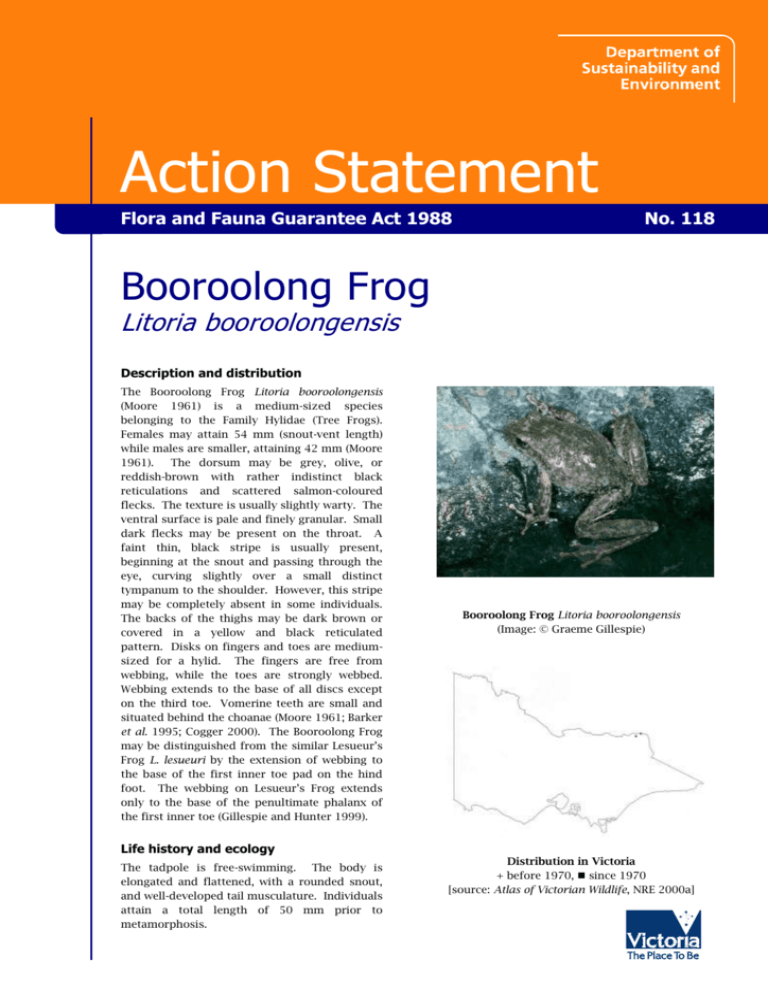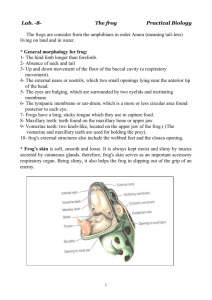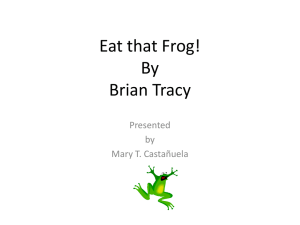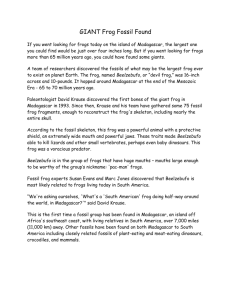Booroolong Frog (Litoria booroolongensis) accessible
advertisement

Action Statement Flora and Fauna Guarantee Act 1988 No. 118 Booroolong Frog Litoria booroolongensis Description and distribution The Booroolong Frog Litoria booroolongensis (Moore 1961) is a medium-sized species belonging to the Family Hylidae (Tree Frogs). Females may attain 54 mm (snout-vent length) while males are smaller, attaining 42 mm (Moore 1961). The dorsum may be grey, olive, or reddish-brown with rather indistinct black reticulations and scattered salmon-coloured flecks. The texture is usually slightly warty. The ventral surface is pale and finely granular. Small dark flecks may be present on the throat. A faint thin, black stripe is usually present, beginning at the snout and passing through the eye, curving slightly over a small distinct tympanum to the shoulder. However, this stripe may be completely absent in some individuals. The backs of the thighs may be dark brown or covered in a yellow and black reticulated pattern. Disks on fingers and toes are mediumsized for a hylid. The fingers are free from webbing, while the toes are strongly webbed. Webbing extends to the base of all discs except on the third toe. Vomerine teeth are small and situated behind the choanae (Moore 1961; Barker et al. 1995; Cogger 2000). The Booroolong Frog may be distinguished from the similar Lesueur’s Frog L. lesueuri by the extension of webbing to the base of the first inner toe pad on the hind foot. The webbing on Lesueur’s Frog extends only to the base of the penultimate phalanx of the first inner toe (Gillespie and Hunter 1999). Life history and ecology The tadpole is free-swimming. The body is elongated and flattened, with a rounded snout, and well-developed tail musculature. Individuals attain a total length of 50 mm prior to metamorphosis. Booroolong Frog Litoria booroolongensis (Image: © Graeme Gillespie) Distribution in Victoria + before 1970, since 1970 [source: Atlas of Victorian Wildlife, NRE 2000a] The eyes are dorso-lateral and the mouth is ventral. Dorsal body colour is uniform rustybrown with some darker mottling, continuing along the tail musculature as two longitudinal stripes. A conspicuous dark brown band is present across the urostylar region. The venter has an almost uniform gold sheen, with some darker patches. The oral disc is large, and a band of oral papillae surrounds the entire margin. There are two anterior rows of labial teeth, and three posterior rows, and moderate, heavily keratinised jaw sheaths (Anstis et al. 1998). The maximum age known for the Booroolong Frog is six years; males attain sexual maturity between one and two years of age, whilst females take three years (G. Gillespie pers. comm.). Breeding occurs between October and December, and clutches average 1 300 eggs per female (G. Gillespie pers. comm.). Distribution and habitat The Booroolong Frog is restricted to New South Wales and north-eastern Victoria, predominantly along the western-flowing streams of the Great Dividing Range, from 200 to above 1 300 m above sea level. The species occurs from catchments draining the Northern Tablelands to the Murray River in the Southern Highlands of NSW and northeastern Victoria. (Heatwole et al. 1995; Anstis et al. 1998; Hunter and Gillespie 1999; New South Wales Wildlife Atlas; NRE 2000a). Within Victoria the Booroolong Frog has been recorded at only two localities (on the same day) in the north-east of the state; Burrowye Creek at Burrowye, and on the Murray River at Jingellic (Gillespie and Hunter 1999). Both of these sites are freehold pastoral land. Current conservation status Victoria Critically endangered (NRE 2000b) Victoria Threatened (SAC 2000) The Booroolong Frog is listed as threatened under the Flora and Fauna Guarantee Act 1988 Decline and threats Despite previous fauna surveys in north-eastern Victoria, and the occurrence of the species in New South Wales close to the Victorian border, the Booroolong Frog was not detected in Victoria until 1999 (Gillespie and Hunter 1999). An accurate assessment of the size of these populations has not been conducted, however they are estimated to number less than 50 adults apiece (G. Gillespie pers. comm.). The Booroolong Frog is restricted to rocky streams. The habitat of both Victorian populations is highly degraded and subject to ongoing threats, including habitat modification resulting from activities such as vegetation clearance, timber harvesting and agricultural practices (particularly grazing), modification of hydrological regimes as a result of irrigation and hydro-electric power generation, predation pressure from introduced fish, and pathogens such as the chytrid fungus which has been implicated in the decline of other frog species in the range of the Booroolong Frog (Berger et. al. 1998). Within New South Wales, the Booroolong Frog was formerly abundant above 800 m, along streams draining the Northern Tablelands (Heatwole et al. 1995). The Booroolong Frog has not been recorded from the Northern Tablelands during the past 15 years despite extensive fauna surveys in recent years, including the North-east Forest Biodiversity Study (NSW NPWS 1994), the Comprehensive Regional Assessment (part of the Regional Forest Agreement process), and others (H. Hines pers. comm.; M. Mahony pers. comm.). Fieldwork over the past 17 years, at Guy Fawkes River and nearby historic localities, where the Booroolong Frog was abundant prior to 1980, has located few individuals (Anstis et al. 1998). Surveys of the type locality and numerous rivers in the vicinity of this locality in the past five years have failed to locate the species (M. Mahony, K. Harris pers. comm. in Anstis et al. 1998, Gillespie 2000). In southern New South Wales there are relatively few historical records compared with the northern part of the range of the species (Australian Museum records; New South Wales Wildlife Atlas). Recent extensive stream surveys targeting riverine frog species in the Southern Highlands failed to locate the species in the Tumut River and Yarrangobilly Creek, where it historically occurred (National Wildlife Collection Records, CSIRO, Canberra); however, the species was located further up-stream along the Yarrangobilly Creek and in 13 other streams in tributaries of the Tumut and upper Murray Rivers (Hunter and Gillespie 1999; Gillespie 1999). These surveys provided new localities for the species, and located the frog in the vicinity of historic records (Australian Museum Records). Overall, there have been very few records of the Booroolong Frog in New South Wales in the past 15 years, contrasting markedly with the 1980s when the species was perceived to be abundant in northern New South Wales (Heatwole et al. 1995). The Booroolong Frog has disappeared from the Northern Tablelands and is now rare throughout most of the remainder of its range. The apparently localised distribution and small population sizes of the species render it vulnerable to catastrophes such as drought and disease. 2 In its final recommendation (SAC 2000) the Scientific Advisory Committee determined that the Booroolong Frog is: significantly prone to future threats which are likely to result in extinction, and very rare in terms of abundance or distribution. Major conservation objective The major conservation objectives for the Booroolong Frog are to initiate surveys to determine the status, distribution and abundance of the species, and to commence management to ameliorate threats to, and protect the habitat of, both known populations, as well as any discovered subsequently. Management Issues Ecological issues specific to the taxon Several potentially threatening processes have operated, or are operating, in various parts of the range of the Booroolong Frog. However, in most cases, the impacts of these processes upon populations of the species have not been examined, and the primary cause(s) of the apparent decline of the Booroolong Frog is only conjecture. Land clearance, forest grazing and timber harvesting have occurred in the vicinity of many streams, or in the headwaters of catchments in which the species has been recorded. Weed invasion, particularly by willows, has grossly modified riparian habitats along many streams in south-east Australia (Anstis and Littlejohn 1996; Anstis et al. 1998; Hunter and Gillespie 1999). Vegetation clearance, grazing and forest management practices may have contributed to the decline of the Booroolong Frog in parts of its range, although this has not been confirmed. Much of the Northern Tablelands of New South Wales, where Booroolong Frogs formerly occurred, has been cleared, although the species persisted in this region long after much of the clearing occurred. In the southern parts of its range the Booroolong Frog still persists in areas that have been cleared for pasture (Gillespie 1999). Many of these streams are highly disturbed by the activities of domestic stock. Following habitat modification, species such as the Booroolong Frog may be able to persist for many generations provided that the basic requirements for population recruitment are met. However, the long-term viability of these populations may be severely compromised, increasing their vulnerability to extinction from environmental stochastic processes, such as drought (Gulve 1994). The availability of uncleared, less-disturbed habitat may increase dispersal and foraging ability, and may also ameliorate the impacts of environmental stresses, such as droughts, fires and predation, by providing refuge areas. Flow regimes of the Murray River catchment in which the Booroolong Frog has been recorded have been modified for irrigation or hydro-electric power generation. Impoundments on streams have potentially substantial adverse impacts upon riverine frog populations, through direct inundation of habitat, and modification of downstream hydrological regimes (Bevitt et al. 1998). Increased stream flows from hydro-electric schemes during the warmer months are likely to have severe adverse impacts upon temperate riverine frog populations. Significant rises in water level and velocity during this period are likely to flush eggs and larvae downstream. Reduced temperatures of sub-surface releases of water from dams during the summer months (Bevitt et al. 1998) are likely to inhibit larval growth and development of obligate stream breeders. These reduced temperatures may also favour introduced trout (which may result in increased predation pressure). Sub-surface waters may also be anoxic, have different pH and higher concentrations of activated heavy metals (Doeg 1987; Ligon et al. 1995; Erskine 1996). Such alterations to water chemistry may be detrimental to eggs, embryos and tadpoles. Reduced peak flows resulting from dams may allow build-up of sediments and colonisation of the stream channel by vegetation. Increased entrained sediments will reduce availability of oviposition sites and refugia for larvae by blanketing the stream bed and filling crevices between rocks. Increased shade from encroachment of vegetation will reduce basking sites for adult frogs, and lower stream temperatures, which may reduce larval growth (Bevitt et al. 1998). Introduced fish occur in many streams throughout the range of the Booroolong Frog. Species which have been recorded include Brown Trout Salmo trutta, Rainbow Trout Oncorhynchus mykiss, European Carp Cyprinus carpio, Goldfish Carassius auratus, Redfin Perch Perca fluviatilis and Gambusia Gambusia holbrooki (McDowall 1996; Hunter and Gillespie 1999; Gillespie 1999; Gillespie and Hines 1999). Several of these are predatory species and may have a significant adverse impact on populations of the Booroolong Frog by preying on eggs and tadpoles (Gillespie and Hero 1999). Brown Trout, Redfin, and Gambusia are widespread throughout streams on the Northern Tablelands of New South Wales where the Booroolong Frog has disappeared (M. Anstis pers. comm.; H. Hines pers. comm.). However, they also occur in streams in which the Booroolong Frog persists in the southern parts of its range 3 (Gillespie 1999). Although tadpoles of the Booroolong Frog appear to be less palatable to trout than are some other temperate riverine species (Gillespie unpublished data), trout may still exert significant predation pressure on populations. the Booroolong Frog, including Lesueur’s Frog (Berger and Gillespie unpublished data). It is likely that the Booroolong Frog is susceptible to this fungus, but its impact upon populations, or its role in observed population declines, is unknown. The introduced predators, foxes and cats, are common and widespread throughout south-eastern Australia, and are potentially major predators of terrestrial frog species such as the Booroolong Frog. Wider conservation issues Frog bones have been detected in fox scats (B. Triggs pers. comm.). Specimens of adult Banjo Frogs Limnodynastes dumerilii have been found in the stomachs of foxes (C. Marks pers. comm.). The impact of foxes and cats on frog populations is unknown and warrants investigation. Several studies have linked climate changes to amphibian population declines (Pounds and Crump 1994) or significant changes in reproductive patterns (Reading 1998). Climatic change has also been implicated in the declines of alpine and subalpine frog species in south-eastern Australia (Osborne et al. 1999). Climatic change or fluctuation may have contributed to the widespread decline of the Booroolong Frog in the north of its range. Severe droughts occurred in south-eastern Australia in the early 1980s, and few Booroolong Frogs have been reported since this period. The impact of drought or other extreme climatic stresses on frog populations are likely to be exacerbated in pastoral areas or other grosslymodified habitats, where availability of refugia otherwise present in natural habitats may be limited or non-existent. Over the past 20 years there has been an increase in the general use of broad-spectrum herbicides (Tyler 1989). The active ingredient in many formulations, glyphosate, and the surfactant have been shown to be toxic to frogs and tadpoles (Bidwell and Gorrie 1995). Formulations which contain glyphosate and surfactant are commonly used to control emergent water weeds. The wide use of these pesticides may have contributed to the decline of the Booroolong Frog in rural landscapes, such as the Northern Tablelands region. Studies of ill and dead frogs have implicated a chytrid fungus in the decline of some tropical and sub-tropical frog species in north Queensland and Central America (Berger et al. 1998; Lips 1999). Several species of temperate riverine frogs have been infected with this fungus (Berger et al. 1998; Berger unpublished data). This fungus has not been detected on wild Booroolong Frogs; however, it has been found in populations of other species within the range of The Booroolong Frog is one of several species of riverine frog occurring in south-eastern Australia that are known to be declining. Information gained during survey and research on the Booroolong Frog may be used to develop threat abatement and management strategies for other riverine frogs, such as the Lesueur’s Frog Litoria lesueuri, Spotted Tree Frog L. spenceri and Leaf Green Tree Frog L. phyllochroa. Previous Management Action Survey Despite extensive surveys for riverine frogs throughout north-eastern Victoria (Watson et al. 1991, Gillespie and Hollis 1996), the Booroolong Frog remained undetected until 1999. The discovery of the Booroolong Frog in Victoria was the result of a brief, one-off survey (Gillespie and Hunter 1999). Considerable survey work for the species has been conducted in New South Wales (Gillespie 1999, 2000; and references therein). Research Developmental and larval biology have been described (Anstis et al. 1998). Preliminary information has been gathered regarding breeding habitat characteristics and adult habitat associations (Anstis et al. 1998; Gillespie 1999). Preliminary information regarding life history has been compiled, including reproductive complement, age to sexual maturity and longevity (Gillespie unpublished data). A preliminary examination of the relative palatability of tadpoles of the Booroolong Frog to native fish and introduced Brown Trout has been conducted (Gillespie 1999). Intended management actions Survey 1. Conduct targeted surveys to determine the distribution and abundance of the Booroolong Frog in the vicinity of Burrowye Creek. Conduct surveys of two tributaries (Koetong and Flaggy Creeks) of the Murray River that have high potential for supporting the species. Responsibility: NRE (Parks, Flora And Fauna Division), Parks Victoria 4 Responsibility: Division) Research and monitoring 2. Monitor known populations of the Booroolong Frog to determine population fluctuations and evaluate management actions. Responsibility: NRE (Parks, Flora and Fauna Division, Forests Service), Parks Victoria 3. Assess the impact of predation by Mosquito Fish Gambusia spp. and other introduced fish on tadpoles of the Booroolong Frog. This can be done experimentally using in-stream experiments. Responsibility: Division) NRE (Parks, Flora and Fauna Site management and habitat protection 4. Liaise with relevant landholders prior to, and during, management activities for the Booroolong Frog. Responsibility: NRE (NE Region, Parks, Flora and Fauna Division) 5. Determine optimum strategies for revegetation of streams, the removal of Willow Trees (Salix spp.) and the use of stock grazing regimes to maintain appropriate vegetation cover. Responsibility: NRE (NE Region, Parks, Flora and Fauna Division) 6. Subject to agreement by landholders, revegetate streamside habitat at Burrowye Creek and construct fences to exclude stock from this site. Vegetation growth may be managed by seasonal grazing by stock. Revegetation should be initially conducted over 50% or less of the area occupied by Booroolong Frogs to determine the consequences of increased vegetation cover on the species. Responsibility: NRE (NE Region, Parks, Flora and Fauna Division), NE Catchment Management Authority Liaison 7. Liaise with New South Wales National Parks and Wildlife Service (which is developing a Recovery Plan for the Booroolong Frog in New South Wales) regarding their recovery process. Responsibility: Division) NRE (Parks, Flora and Fauna Other desirable management action 8. Design and produce extension materials to educate landholders and the public in best practises for protecting the habitat of the Booroolong Frog on private property. 9. NRE (Parks, Flora and Fauna Encourage the co-operation of local Landcare groups in rehabilitation works for the habitat of the Booroolong Frog. Responsibility: NRE (NE Region), NE Catchment Management Authority References Anstis, M. and Littlejohn, M. J. (1996) The breeding biology of Litoria subglandulosa and L. citropa (Anura: Hylidae), and a re-evaluation of their geographic distribution. Trans. Roy. Soc. S.A. 120: 83-99. Anstis, M., Alford, R. A. and Gillespie, G. R. (1998) Breeding biology of Litoria booroolongensis Moore and L. lesueuri Dumeril and Bibron (Anura: Hylidae). Trans Roy. Soc. S.A. 122: 3343. Barker, J., Grigg, G. and Tyler, M. J. (1995) A Field Guide to Australian Frogs (2nd Edition). Surrey Beatty, Chipping Norton, NSW. Berger, L., Speare, R., Daszak, P., Earl Green, D., Cunningham, A. A., Goggin, C. L., Slocombe, R., Ragan, M. A., Hyatt, A. D., McDonald, K. R., Hines, H. B., Lips, K. R., Marantelli, G. and Parkes, H. (1998) Chytridiomycosis causes amphibian mortality associated with population declines in the rainforests of Australia and Central America. Proc. Nat. Acad. Sci. 95: 9031-9036. Bevitt, R., Erskine, W., Gillespie, G., Harris, J., Lake, P. S., Miners, B., Rutherford, R. and Varley, I. (1998) Expert Panel Environmental Flow Assessment of Various Rivers Affected by the Snowy Mountains Scheme. Report to the NSW Department of Land and Water Conservation, Sydney. Bidwell, J. R. and Gorrie, J. R. (1995) Acute Toxicity of a Herbicide to Selected Frog Species. Prepared for the Western Australian Department of Environmental Protection, Perth. Curtin Ectotoxicology Program, Curtin University of Technology. Cogger, H. G. (2000) Reptiles and Amphibians of Australia. (6th Edition). Reed: Frenchs Forest. Doeg, T. J. (1987) Response of the macroinvertebrate fauna of the Mitta Mitta River, Victoria, to the construction and operation of the Dartmouth Dam. 2. Irrigation release. Occ. Pap. Mus. Vic. 1: 101-128. DSE (2003) “Advisory List of Rare or Threatened Vascular Plants in Victoria – 2003”. Department of Sustainability and Environment, Victoria, Australia. Erskine, W. D. (1996) Downstream hydrogeomorphic impacts of the Eildon Reservoir on the mid-Goulburn River, Victoria. Proc. Roy. Soc. Vic. 108: 1-15. Gillespie, G. R. (1999) Survey of the Distribution and Habitat of the Booroolong Frog Litoria booroolongensis on the South-western Slopes of the Great Dividing Range in New South Wales. Report to the NSW National Parks and 5 Wildlife Service, Queanbeyan. Arthur Rylah Institute, Department of Natural Resources and Environment, Victoria. Gillespie, G.R. (2000) Survey, Monitoring and Management of the Booroolong Frog and Spotted Tree Frog in New South Wales. Report to the NSW National Parks and Wildlife Service, Queanbeyan. Arthur Rylah Institute, Department of Natural Resources and Environment, Victoria. Gillespie, G. R. and Hero, J.-M. (1999) Potential impacts of introduced fish and fish translocations on Australian amphibians. In: A. Campbell (Ed.) Declines and Disappearances of Australian Frogs. Environment Australia. Gillespie, G. R. and Hines, H. (1999) Status of temperate riverine frogs in south-eastern Australia. In: A. Campbell (Ed.) Declines and Disappearances of Australian Frogs. Environment Australia. Gillespie, G.R. and Hunter, D. (1999) The Booroolong Frog Litoria booroolongensis Moore (Anura: Hylidae): an addition to the frog fauna of Victoria. Vic. Nat. 116 (3): 112-114. Gulve, P. S. (1994) Distribution and extinction patterns within a northern metapopulation of the pool frog, Rana lessonae. Ecology 75: 13571367. Heatwole, H., De Bavay, J., Webber, P. and Webb, G. (1995) Faunal survey of New England. IV. The frogs. Mem. Qld. Mus. 38: 229-249. Hunter, D. and Gillespie, G. R. (1999) The distribution, abundance and conservation status of riverine frogs in Kosciuszko National Park. Aust. Zool. 31: 198-209. Ligon, F. K., Dietrich, W. E. and Trush, W. J. (1995) Downstream ecological effects of dams. Bioscience 45: 183-192. Lips, K. R. (1999) Mass mortality and population declines of anurans at an upland site in Western Panama. Cons. Biol. 13: 117-125. McDowall, R. M. (Ed.) (1996) Freshwater Fishes of South-eastern Australia. (2nd Edition), Reed, Sydney. Moore, J. A. (1961) The frogs of eastern New South Wales. Bull. Amer. Mus. Nat. Hist. 121: 149-386. NRE (2000a) Atlas of Victorian Wildlife (electronic fauna database). Department of Natural Resources and Environment, Victoria. NRE (2000b) Threatened Vertebrate Fauna in Victoria – 2000: A systematic list of vertebrate fauna considered extinct, at risk of extinction or in major decline in Victoria. Department of Natural Resources and Environment, Victoria. NSW NPWS (1994) Fauna of North-east NSW Forests. North-east Forests Biodiversity Study Report No. 3. Unpublished Report, NSW National Parks and Wildlife Service: Hurstville. Osborne, W. S., Hunter, D. A. and Hollis, G. J. (1999) Population declines and range contraction in Australian alpine frogs. In: A. Campbell (Ed.) Declines and Disappearances of Australian Frogs. Environment Australia. Pounds, J. A. and Crump, M. L. (1994) Amphibian declines and climate disturbance: The case of the Golden Toad and the Harlequin Frog. Cons. Biol. 8: 72-85. Reading, C. J. (1998) The effect of winter temperature on the timing of breeding activity in the common toad Bufo bufo. Oecologia 117: 469-475. SAC (2000) Final Recommendation on a nomination for listing: Litoria booroolongensis Booroolong Frog (Nomination no. 494). Scientific Advisory committee, Flora and Fauna Guarantee. Department of Natural Resources and Environment: Melbourne. Tyler, M. J. (1989) Australian Frogs. Viking O’Neil, Melbourne. Watson, G. F., Littlejohn, M. J., Hero, J.-M. and Robertson, P. (1991). Conservation Status, Ecology and Management of the Spotted Tree Frog (Litoria spenceri). Arthur Rylah Institute Technical Report Series No. 116. Department of Conservation and Environment: Victoria. Compiled by Nick Clemann, Arthur Rylah Institute, Department of Natural Resources and Environment. Further information can be obtained from Department of Sustainability and Environment Customer Service Centre on 136 186. Flora and Fauna Guarantee Action Statements are available from the Department of Sustainability and Environment website: http://www.dse.vic.gov.au This Action Statement was prepared under section 19 of the Flora and Fauna Guarantee Act 1988 under delegation from Chloe Munro, Secretary, Department of Natural Resources and Environment, June 2001. © The State of Victoria, Department of Sustainability and Environment, 2003 Published by the Department of Sustainability and Environment, Victoria. 8 Nicholson Street, East Melbourne, Victoria 3002 Australia This Action Statement was approved in 2001 and remains current. This version has been prepared for web publication. It retains the original text of the action statement, although some details, such as the names of organisations, may have been updated. This publication may be of assistance to you but the State of Victoria and its employees do not guarantee that the publication is without flaw of any kind or is wholly appropriate for your particular purposes and therefore disclaims all liability for any error, loss or other consequence which may arise from you relying on any information in this publication. ISSN 1448-9902 6







